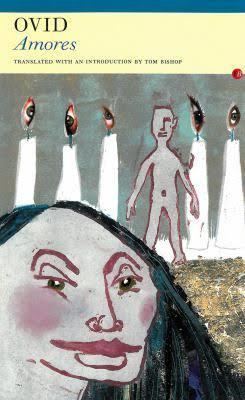Originally published 1820 | ||
 | ||
Similar Ovid books, Other books | ||
Amores is Ovid's first completed book of poetry, written in elegiac couplets. It was first published in 16 BC in five books, but Ovid by his own account later edited it down into the three-book edition that survives today. The book follows the popular model of the erotic elegy, as made famous by figures such as Tibullus or Propertius, but is often subversive and humorous with these tropes, exaggerating common motifs and devices to the point of absurdity.
Contents
History
Speculations as to Corinna's real identity are many, if indeed she lived at all. It has been argued that she is a poetic construct copying the puella-archetype from other works in the love elegy genre. The name Corinna may have been a typically Ovidian pun based on the Greek word for "maiden", "kore".
Though most of this book is rather tongue-in-cheek, some people didn't take it that way and this could be the reason or part of the reason why Ovid was banished from Rome. However, his banishment probably has more to do with the Ars Amatoria, written later, which offended Augustus. There is also a connection between Ovid and Augustus' daughter, Julia, who was also exiled.
Summary
The Amores is a poetic first person account of the poetic persona's love affair with an unattainable higher class girl, Corinna. The plot is linear, with a few artistic digressions such as an elegy on the death of Tibullus.
Book 1
The book has a ring arrangement, with the first and last poems concerning poetry itself, and 1.2 and 1.9 both contain developed military metaphors.
Book 2
Book 3
3.1
3.2 - Ovid woos a girl at the races, despite perhaps only just having met her. Ovid seems to be very desperate - as shown by quickly making his move. The reader is left unsure whether his advances were truly accepted or whether Ovid (chooses to?) misinterpret the girl's rejections.
3.3
3.4 - Ovid tries to persuade a man to let him have sex with his wife.
3.5 - Ovid has a dream about a white cow that has a black mark. The dream symbolises an adulterous woman who now has been forever stained by the mark of adultery.
3.6
3.7
3.8
3.9
3.10
3.11
3.12
3.13
3.14 - Ovid instructs his partner to not tell him about her affairs. Instead, although he knows he cannot keep her to himself, he wants her to deceive him so that he can pretend not to notice.
3.15 - Ovid bids farewell to love elegy.
Love elegy
Ovid's Amores are firmly set in the genre of love elegy. The elegiac couplet was used first by the Greeks, originally for funeral epigrams, but it came to be associated with erotic poetry.
Familiar themes include:
It has been regularly praised for adapting and improving on these older models with humour.
Use of allusions
The poems contain many allusions to other works of literature beyond love elegy.
The poet and his immortality
Poems 1.1 and 1.15 in particular both concern the way poetry makes the poet immortal, while one of his offers to a lover in 1.3 is that their names will be joined in poetry and famous forever.
Use of humour
Ovid's love elegies stand apart from others in the genre by his use of humour.
Love and war
Amores I.1 begins with the same word as the Aeneid, "Arma" (an intentional comparison to the epic genre, which Ovid later mocks), as the poet describes his original intention: to write an epic poem in dactylic hexameter, "with material suiting the meter" (line 2), that is, war. However, Cupid "steals one (metrical) foot" (unum suripuisse pedem, I.1 ln 4), turning it into elegiac couplets, the meter of love poetry.
Ovid returns to the theme of war several times throughout the Amores, especially in poem nine of Book I, an extended metaphor comparing soldiers and lovers (Militat omnis amans, "every lover is a soldier" I.9 ln 1).
Other Roman authors
Ovid's popularity has remained strong to the present day. After his banishment in 8 AD, Augustus ordered Ovid's works removed from libraries and destroyed, but that seems to have had little effect on his popularity. He was always "among the most widely read and imitated of Latin poets. Examples of Roman authors who followed Ovide include Martial, Lucan, and Statius.
Post-Classical Period
The majority of Latin works have been lost, with very few texts rediscovered after the Dark Ages and preserved to the present day. However in the case of Amores, there are so many manuscript copies from the 12th and 13th centuries that many are “textually worthless”, copying too closely from one another, and containing mistakes caused by familiarity. Theodulph of Orleans lists Ovid with Virgil among other favourite Christian writers, while Nigellus compared Ovid's exile to the banishment of St. John, and imprisonment of Saint Peter. Later in the 11th century, Ovid was the favourite poet of Abbot (and later Bishop) Baudry, who wrote imitation elegies to a nun - albeit about Platonic love. Others used his poems to demonstrate allegories or moral lessons, such as the 1340 Ovid Moralisé which was translated with extensive commentary on the supposed moral meaning of the Amores. Wilkinson also credits Ovid with directly contributing around 200 lines to the classic courtly love tale Roman de la Rose.
Christopher Marlowe wrote a famous verse translation in English.
